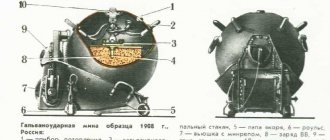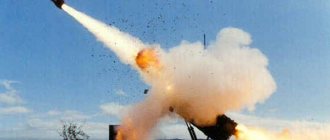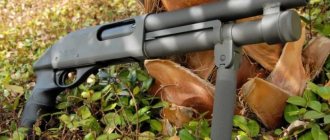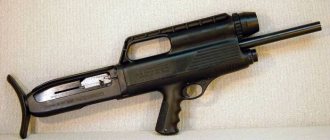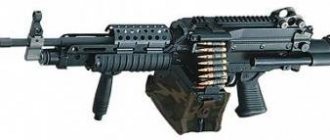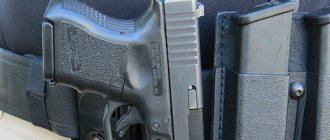Fuzes
Fuzes
In the section where a description of the design of projectiles is given, the words were often mentioned: head fuse, bottom fuse, spacer tube.
What are these mechanisms, without which not a single projectile (except a sub-caliber one) can operate? According to the method of action, fuses and tubes are divided into impact and remote, and according to their location - into head and bottom.
If you take a modern impact fuse, then on its head you will see a tap, on the sides of which there are two marks with the letters “O” and “Z”. From the description of the effect of shells, you already know that there is a fragmentation and high-explosive effect of shells on the target. To obtain one or another effect of a projectile on a target, we need to regulate the moment of explosion of the projectile in relation to the moment of its meeting with the obstacle. This is achieved by different fuse settings.
When the fuse is set to instant action, the projectile explodes in less than 0.001 seconds after it hits an obstacle. The explosion occurs before the projectile penetrates into the barrier, so the depth of the resulting crater is insignificant compared to its diameter. The result is maximum fragmentation effect.
It is necessary to point out that fuses that produce a fragmentation effect can only be head fuses.
When the fuse is set to a high-explosive, or, as they also say, inertial, action, the explosion of the projectile occurs 0.005 seconds or more after it hits an obstacle. In this case, the projectile manages to penetrate somewhat deeper into the obstacle before the explosion.
An increase in the high-explosive effect of a projectile is achieved by further deepening it into the barrier until the moment of explosion. The latter is ensured by placing a powder retarder in the path of the fire beam that causes the explosion. This installation of the fuse is called delayed.
Let's consider the application and principle of operation of head and bottom impact fuses.
As the name suggests, the head fuses are screwed into a point located at the head of the projectile. This type of fuses is intended for the final loading of fragmentation, high-explosive fragmentation and high-explosive grenades and smoke shells.
Modern fuses consist of an impact mechanism and a safety device, the purpose of which is to ensure safety during storage and transportation of fuses, as well as when handling them.
The main parts of the impact mechanism are: an instantaneous firing pin with a sting and an inertial firing pin with an igniter primer. Installation for high-explosive action is carried out using a cap screwed onto the head of the fuse (Fig. 46).
Rice. 46. Scheme of operation of the head fuse
.
If the cap is screwed on, then at the moment the projectile meets the obstacle, the instantaneous firing pin remains in place, and the inertial firing pin, moving forward under the influence of inertial forces, punctures the primer - the igniter. A beam of fire from the igniter primer is transmitted to the detonator primer and ignites it; the detonator explodes and causes the entire charge to detonate.
Let's consider the action of the head fuse when firing without a cap. In this case, the instantaneous firing pin, having encountered an obstacle, is pressed inward, towards the inertial firing pin, and punctures the igniter primer. As a result of this, the fuse, and therefore the projectile, acts instantly. As you already know, this action is called fragmentation.
How is the fuse set for delayed action?
For this purpose, fuses are equipped with special devices - taps. By combining the installation of the cap and the valve, the following fuse settings can be obtained: 1) the cap is removed, the valve is open - fragmentation action; 2) the cap is on, the tap is open - high-explosive action; 3) the cap is on, the tap is closed - the delayed action is longer; 4) the cap is removed, the tap is closed - slow action. In practice, the first three settings are usually used.
At the moment of firing, the fuse is “cocked” under the influence of inertial forces, that is, the safety devices release the inertial firing pin, after which it is enough to slow down the projectile in flight for the projectile to explode.
Since there are many fuses used in artillery, there is a mark on the body of each fuse that determines its name and type. We have analyzed the principle diagram of the operation of the head fuse. We do not have the opportunity to dwell on the description of all existing fuses in this book.
For the final loading of tank and anti-tank artillery shells, as well as large-caliber concrete-piercing and high-explosive shells, bottom fuses are used. Due to the peculiarity of the action of projectiles, bottom fuses are screwed into the bottom part of the projectile.
To equip concrete-piercing projectiles with a caliber of 152 millimeters and higher, as well as high-explosive large-caliber projectiles, bottom fuses with several settings are used. A representative of this group of fuses is the KTD-2 fuse, which is equipped with a delay device and a tap. This fuse device allows for three settings:
— basic installation, in which the valve arrow is opposite the inscription “PC” on the body; With this installation, fuses are released from the factory; this installation is also called “traveling”;
— installation for high-explosive action; The tap arrow in this case is opposite the letter “O”;
— setting for slow action; the tap arrow is opposite the letter “Z”. It is necessary to warn that it is prohibited to shoot when installing the fuse on the “PC”, because in this case the fuse will not work.
A remote fuse is used to explode a high-explosive fragmentation grenade before it hits an obstacle. A high-explosive fragmentation grenade equipped with a remote fuse is called a high-explosive grenade, and the shooting itself is called firing a high-explosive grenade. This type of shooting is used to increase the fragmentation effect of a grenade.
The D-1 remote fuse is widely used in ground artillery. This fuse has two actions: remote and impact. If for some reason the projectile does not explode on its trajectory, it will still explode due to the action of the impact mechanism of the fuse.
Before loading the fuse, the safety cap must be unscrewed.
After this, a special key is used to install the fuse at the commanded division.
At the moment of firing, the remote tip (Fig. 47) settles back by inertia and, compressing the spring, punctures the remote capsule.
Rice. 47. Fuse D-1.
The powder press placed in the channel of the upper spacer ring immediately begins to burn. When the fire reaches the transfer channel, the press-fit in the middle spacer ring will begin to burn, and from there, through the transfer channel, the fire is transferred to the lower spacer ring, then the fire reaches the detonator cap, and from it through the transfer charge to the detonator. The explosion of the detonator will cause the entire projectile to explode. Setting the fuse to division “125” corresponds to the maximum burning time of the remote device (45 seconds). It is prohibited to install the fuse less than 5 divisions, since in this case the path of fire along the remote device is so small that the shell will explode in the immediate vicinity of the gun and the fragments can disable the crew of the gun.
The impact mechanism is turned off before the shot, since the sting, fixed in the cigarette, is locked with a stopper resting on the powder column. During the flight, when the column burns out, the stopper releases the cigarette, which moves forward due to the fact that the projectile is slowed down by the force of air resistance. At the moment the projectile hits the barrier, the cigarette with the sting is sharply pulled back and the igniter primer of the impact mechanism is pierced. From the igniter capsule, a beam of fire is transmitted to the detonator capsule.
For the final loading of shrapnel and special projectiles with a powder expelling charge (incendiary, illuminating and propaganda), spacer tubes are used. Remote tubes have three settings: remote action, buckshot and impact.
At the moment of firing, a heavy striker, called a remote striker, obeying the law of inertia, tends to remain in place, compresses the spring holding it and pierces the capsule with its sting. The fire resulting from the explosion of the primer is transmitted through the transfer channel to the powder mass pressed into the upper spacer ring. From there, the beam of fire is transmitted through the transfer holes to the middle and then to the lower distance rings. After this, the fire enters the powder firecracker through the ignition hole and, after its explosion, is transferred through the central tube to the expelling charge.
Installing the tube is similar to installing a remote fuse. Consequently, the duration of combustion of the tube depends on the location of the transfer holes of the spacer rings. In Fig. Figure 48 shows an approximate diagram of the passage of a flame in a spacer tube.
To install remote tubes, you must use special installation keys. Do not use other tools to avoid an accident.
Rice. 48. Diagram of the passage of the flame in the spacer tube
.
The remote fuse that saved London and the American fleet
The Anglo-Saxon allies of World War II collaborated extensively in the development and production of new and existing technologies to support military operations and intelligence gathering.
Several technologies invented in Great Britain turned out to be critical for the armed forces and were widely used by the Americans during World War II (no one was going to share such technologies with the Soviet Union).
Military historians place the invention and use of proximity fuses in first place among all such innovations and technologies.
Relevance
The urgency of developing a practical artillery fuze that did not rely on time-to-target calculations or even physical contact with the target was obvious to anyone familiar with the limitations of traditional anti-aircraft artillery.
Gunners of the day acknowledged that shooting down a small, fast-moving, high-flying aircraft was mostly a matter of luck. Periodic studies have shown that, statistically, a direct hit can only occur with one of approximately 1,200 anti-aircraft shells fired.
Admiral Arleigh Burke, who commanded a fleet of American destroyers in the Solomon Islands campaign in 1942–1943, wrote after the war about the difficulties of defending against Japanese air attacks, especially after dark. "They're good for harassing enemy aircraft at night, but that's about it."
Prerequisites
Before the invention of the proximity fuze, detonation was caused by direct contact, a timer set at launch, or an altimeter.
All of these early methods used had disadvantages.
• The likelihood of a direct hit on a small moving target is low; a projectile that misses its target will not explode.
• A time-triggered or altitude-triggered fuze requires good prediction by the gunner and accurate timing on the fuze. If something is wrong, then even with the correct aiming, the shells can explode “uselessly” before reaching the target or after passing it.
Firing from anti-aircraft guns during World War II.
Air defenses using timed fuses had to fire a lot of shots to bring anything down.
A non-contact fuse does not have these disadvantages
, the projectile or missile only needs to fly past the target at a fairly short distance.
A proximity fuse is a fuse that automatically detonates an explosive device when the distance to the target becomes less than a predetermined value.
Regardless of the sensor used, a preset sensing distance is calculated so that the explosion occurs close enough to the target that it is either destroyed or severely damaged.
In the period leading up to World War II, the chances of anti-aircraft guns hitting their targets were slim.
The calculations required to calculate where the projectile's trajectory would intersect with the target were so complex that, on average, tens of thousands of projectiles had to be fired to hit the target.
This problem became especially acute during the US-Japanese confrontation after Pearl Harbor.
In its initial period, Japanese aviation turned out to be more effective than the shipborne air defense systems of the American fleet.
Story
The Aichi D3A
was the first Japanese aircraft to bomb American targets in the war, starting with Pearl Harbor, and American bases in the Philippines. They sank more Allied warships than any other Axis aircraft.
During 1942 D3A1
and
D3A2
contributed significantly to the sinking of three US Navy aircraft carriers:
Lexington
at the Battle of the Coral Sea,
Yorktown
at the Battle of Midway, and
Hornet
at the Battle of the St. Croix Islands.
They also damaged the USS Enterprise.
both in the Battle of the Eastern Solomon Islands and the Battle of the St. Croix Islands.
During the war, D3A dive bombers often combined their attacks on enemy warships with the IJN Nakajima B5N Kate
; Therefore, enemy ships were often sunk by a combination of bombs and torpedoes.
The Nakajima B5n Kate was the standard carrier-based torpedo bomber of the Imperial Japanese Navy for most of World War II.
However, there have been instances where only D3As have made attacks, or at least made strikes that resulted in the sinking of enemy ships.
Japanese air superiority ended early in 1943.
On the morning of January 5, 1943, four Japanese Aichi D3A dive bombers surprised a US Navy task force operating off Guadalcanal.
One of them hit the New Zealand light cruiser Achilles before the group broke off the attack.
Belatedly, the Americans began to respond and fired almost after the enemy planes.
USS Helena
, one of the first three ships to receive the new remote fuse, fired on a dive bomber heading towards its task force.
The cruiser fired two shots, from one of which the enemy plane caught fire and fell into the water.
USS Helena (CL-50) was a Brooklyn-class light cruiser built for the United States Navy in the late 1930s, the ninth and final member of the class
. Although the battle did not attract public attention at the time, it was a watershed moment in the history of artillery and air power. battles - for the first time an enemy aircraft was deliberately shot down by a remote charge.
Later, also in early 1943, during the Solomon Islands campaign, the proximity fuze showed its full advantages when Admiral William Halsey's task forces were subjected to repeated night attacks by Mitsubishi G4M torpedo bombers (Allied name "Betties").
Mitsubishi G4M "Betty"
As Samuel Eliot Morison writes in his History of U.S. Naval Operations in World War II: “Smoking fuselages and burning wreckage on the ground testified to the accuracy of the anti-aircraft batteries and the effectiveness of the top-secret Mark-32 shell fuze.
, which passed one of the first combat tests here.”
Five aircraft were shot down, but the convoy was saved by "excellent anti-aircraft formation combined with fire control radar and a deadly proximity fuse."
In 1943 alone, the Air Defense Command estimated that more than half of all Japanese aircraft were shot down by ship fire, although only 25 percent of the shells fired were equipped with proximity fuzes - VT.
Scientific background
British scientists began working on a proximity fuse in the late 1930s and solved many of its inherent problems.
But their efforts were stymied by cost overruns and the problem of miniature components, especially those suitable for mass production. When war was on the threshold, they shared their work with the Americans.
American contribution
Founded in the summer of 1940, the US National Defense Research Committee (NDRC) served as a liaison between the National Academy of Sciences and the Pentagon.
The committee was chaired by the eminent MIT-educated electrical engineer and inventor Vannevar Bush. To solve countless scientific military problems, the committee turned to various specialized departments.
One such unit was Section-T, which was tasked with creating a workable proximity fuse for large-caliber artillery.
In August 1940,
the section came under the leadership of Merle Tuve, an experienced pioneering physicist at the Carnegie Institution in Washington.
A new research center, called the Applied Physics Laboratory (APL), was created under the auspices of Johns Hopkins University.
The main military customer for his research was the Navy.
In attempting to develop a workable fuse, Section-T scientists, engineers and ammunition experts encountered a number of problems:
• Creating an optical, magnetic, or electronic feedback mechanism that would signal the “explosion” of an artillery shell traveling at a muzzle velocity of 2,600 feet per second as it approached an enemy aircraft traveling at 300 miles per hour.
• Placing the radar device (transmitter and receiver) in a 5-inch projectile that is only 20¾ inches long and already packed with 7 pounds of explosive.
• Shrinking such an electronic device to the size of a milk bottle
in an era when no one could imagine transistors or integrated circuits.
• Development of a power source of sufficient power and strength to operate the fuse and operate in the temperature range from 100 to minus 50 degrees.
• Developing a fuze that could withstand the impact of a 5-inch gun shot—an acceleration of 20,000 times the force of gravity—as well as the centrifugal force of a spinning projectile at 500 revolutions per second.
• Provide safety features to ensure safe handling and prevent accidental detonation.
• Production of universal fuses suitable for use in a number of US and UK weapons.
• Developing technology for fast, high-quality mass production—millions of units, with components sourced from multiple American factories.
However, it turned out that the solutions to the problems were not beyond the capabilities of American scientists, engineers, inventors, technicians, munitions experts and manufacturers.
They really did it!
Details of the VT fuze
But how did they make it small enough?
At that time, there was no "solid state" electronic circuitry. Radios used convex glass vacuum tubes. Although miniature vacuum tubes were used in hearing aids, they were in no way suitable for use in artillery shells.
Developing miniature glass vacuum tubes that could withstand gunfire became a top priority for physicist James Van Allen. This took almost a year of research, experimentation and field testing using a series of powerful weapons and explosives.
Meanwhile, APL researchers were refining a transceiver circuit originally developed by British scientists, and National Carbon Co. developed a workable power source. During the summer and fall of 1941, development of other electronic components and devices continued.
The wartime urgency felt by those working on the fuze project was starkly expressed in a series of instructions posted on the walls of Tove's laboratory by the serious and highly motivated head of Section T:
I don't want some fool in this lab trying to save money. I just wish it would save time.
The fuze eventually developed by Section-T and its partners used a miniature radio transmitter and receiver with an amplifier.
It included a thyratron trigger, a gas-filled tube that acted as an electronic switch. It also used a battery-powered safety device to prevent accidental explosion.
As the projectile flew, the transmitter sent out a continuous radio signal that bounced off the moving target - similar to how radar does.
The receiver recorded a return signal, the intensity of which increased as the projectile approached the target. Once the signal level exceeded a certain threshold, it activated the thyratron trigger, releasing the electrical charge stored in the capacitor.
This charge set off an electrical detonator, which in turn set off the main explosive.
Subsequently, distance sensors based on the Doppler effect were developed.
Due to the significant speed of the projectile relative to the target, the signal reflected from the target has a frequency shift. This frequency-shifted signal is fed to a mixer, at the output of which the difference frequency is separated by a filter. The amplitude of the difference frequency depends on the range to the target. It's one thing to make a miniature Doppler radar out of vacuum tubes; it's quite another thing to have the device work after being fired from a cannon!
The Johns Hopkins University Applied Physics Laboratory managed to create a revolutionary fuse that changed the balance of power in America's favor.
The combat effects of fuzes, whether used in shells fired from anti-aircraft guns or ground artillery, were immediate, devastating and demoralizing to enemies.
By the end of the war, an army of workers had assembled and installed more than 22 million of this type of innovative fuze
, (each containing about 130 miniature electronic parts), at a total cost of more than $1 billion in 1940s dollars (roughly $15 billion today).
The program remained a closely guarded secret throughout the war, so the Japanese and Germans, exposed to such fire, never understood why Allied artillery suddenly became so hyper-accurate and deadly.
Fuze production lines have opened at several sites.
One of the first tests of the configuration of tiny electronic components and dry cell batteries occurred on January 29, 1942, when researchers mounted them in 5-inch projectiles and fired them from a standard anti-aircraft gun.
Fifty-two percent of the fuses fired were successful.
This success rate was high enough that the Naval Weapons Office assigned Crosley Corp. from Cincinnati, Ohio, to begin pilot production of the fuse. To disguise the significance of the device, the bureau implicitly called it a variable-time fuze - VT.
The following month, National Carbon developed an improved wet cell battery. The size and shape provided greater stability and longer shelf life by separating the electrolyte liquid in the glass ampoule.
The muzzle blast could shatter the glass and release the electrolyte, which, driven by the centrifugal force of the rotating projectile, would flow onto the stacked carbon and zinc plates, thus activating the battery - an ingenious solution.
Researchers worked tirelessly to improve the fuse. To ensure defeat, it had to explode the moment the target was within the effective 60-meter explosion of a standard 5-inch anti-aircraft shell.
Tests
By the summer of 1942,
Tove and his team were ready to test the VT fuze under simulated combat conditions.
On August 12, the newly commissioned light cruiser USS Cleveland
, then sailing the Chesapeake Bay, began a planned two-day live-fire evaluation of the new fuze.
The targets were three drones (small radio-controlled aircraft) - all of which were shot down by gunners on the first day with just four bursts of proximity fuse air defense, despite evasive maneuvers by controllers.
Design engineers continued to adapt fuzes for use in various calibers of American and British anti-aircraft guns, as well as other naval guns.
Thus, shells suddenly appeared that half the time exploded close to the target, potentially shooting down an enemy aircraft in just a few dozen or a few hundred rounds.
This solved several problems.
Ships were now less likely to run out of anti-aircraft ammunition during long cruises, and could defend themselves much better against coordinated bombing attacks.
The fuses were also modified for installation in aircraft bombs and field artillery pieces.
Modifications
In practice, this meant producing eight different fuses for the US Navy, 12 for the US Army, four for the Royal Navy and six for the British Army.
As the proximity fuze proved itself in combat, demand for it grew.
Ultimately, there were about 70 versions of the device in production, requiring constant testing, modifications, and changes on the assembly line.
Secrecy
Advanced top-secret fuses were sent to the front lines with strict instructions to use them only when the enemy could not find unexploded ordnance.
The United States and Great Britain went to great lengths to ensure that not a single sample fell into the hands of the enemy, and at the same time the Soviet allies. To this end, the device was initially restricted to naval use, primarily to ensure that enemy forces could not retrieve unexploded ordnance for study and copying for use against allies.
Efficiency
In 1943, more than half of all Japanese aircraft were shot down by VT anti-aircraft missile systems.
The use of the new fuze in the Navy's 5-inch anti-aircraft guns expanded throughout the Pacific during the last two years of the war.
Some naval historians believe that the Japanese resorted to kamikaze attacks by inexperienced pilots in part because of the terrible losses experienced by experienced crews to American anti-aircraft fire—not that kamikazes were immune to VT-fuzed shells.
Although proximity fuzes were available for many applications, the embargo on their use on land remained until the summer of 1944, when Germany began bombing London using V-1 flying bombs.
While not aimed at specific targets, the rockets have claimed tens of thousands of civilian lives and caused extensive damage. Launched across the English Channel and approaching speeds of 400mph, the unmanned missiles were difficult to detect and even more difficult to hit.
Defense of England
Section-T began modifying proximity fuses to target small, fast V-1s.
Special fuses were installed in British 3.7-inch anti-aircraft ammunition and US 90-mm anti-aircraft shells.
In mid-July, the Allies moved about 500 guns to installations along the canal, where their fire did not pose a danger to RAF fighters. During the last four weeks of the 80-day campaign, the results were impressive.
Allied shore batteries destroyed 24 percent of all deployed V-1s in the first week, 46 percent in the second week, 67 percent in the third week, and a whopping 79 percent in the final week.
Use in the military
In 1944, these rounds were finally cleared for ground combat, and their greatest moment came during the Battle of the Bulge, when General George S. Patton ordered their use against concentrations of tank crews and infantry.
The shells must have exploded about 50 feet above the ground.
Shrapnel ripped through men and light equipment and knocked out entire armored and infantry units due to the sheer numbers of wounded and killed troops.
In ground combat, proximity fused shells caused terrible damage to people and vehicles.
The proximity fuze demonstrated its value in two significant military campaigns during the final stages of the war in Europe.
Fight for Antwerp
The Allied battle for control of Antwerp in late 1944 highlighted the key role of the Belgian port in supporting the land offensive against Germany.
The British 11th Armored Division captured the port on 4 September. Over the next five months, the Germans responded with round-the-clock launches of some 2,500 V-1 flying bombs and V-2 ballistic missiles aimed at destroying the vital port. APL physicists quickly developed a modified fuze for 3.7 and 90 mm anti-aircraft shells to counter this threat.
The devices went into production at the Crosley plant, and British Prime Minister Winston Churchill authorized a special flight of Lancaster bombers to carry the fuses from Cincinnati to Antwerp.
Since air attacks were largely prevented by this, the large supply port remained open throughout the war.
Battle of the Bulge
On December 16, 1944,
Germany launched its last major offensive on the Western Front, the Battle of the Bulge.
By that time, proximity fuzes had been developed and tested for all calibers of American artillery, and large stocks of ammunition were sent to the European theater.
The embargo on ground proximity fuzed munitions for both anti-aircraft and field artillery was lifted within two days of the initial attacks, which included the last concentrated air attacks by the Luftwaffe.
The effect was immediate and stunning. From then on, until the Allies crossed the Rhine into Germany, more than 1,000 enemy aircraft were shot down by Allied air defense fire.
Moreover, parallel developments in fire control radars allowed gunners to destroy unseen targets on hillsides and under forest canopies day and night.
Because the artillery had high velocity, German soldiers could not hear the shells until they exploded overhead. The trenches provided no protection, and shrapnel even penetrated bunkers reinforced with logs.
The interrogation materials of German prisoners of war often contained evidence of their panic.
“They realized that they were faced with new artillery, but they could not understand how it worked or how to evade it.” In fairness, it should be recalled that estimates of the forces involved in the Battle of the Ardennes and the losses of the parties vary depending on the sources.
The Americans tended to exaggerate the strength and losses of the Germans, and the Germans - the Americans. The same applies to the assessment of the role of remote fuses in this final battle.
Conclusion
In 1995–1997, materials from Operation Venona were declassified.
This is what American intelligence agencies called the systematic collection and decoding of intercepted radio messages between the Soviet intelligence station in the United States and Moscow from 1943 to 1945.
Operation Venona began in 1943 and lasted almost 40 years. The Venona documents, in particular, indicate that the American radio engineer Julius Rosenberg, who was later executed along with his wife on charges of espionage for the USSR, actually worked for Soviet intelligence, and did so solely for ideological reasons.
Most often, Rosenberg's name is mentioned in connection with the American and Soviet atomic programs. However, the information conveyed to him was by no means exhausted by atomic secrets.
It is known that in December 1944 he obtained and handed over detailed documentation and a sample of a finished radar fuse to Soviet intelligence officer Alexander Feklisov.
Soviet experts highly appreciated this product. At their request, a Resolution of the Council of Ministers of the USSR was adopted on the creation of a special design bureau for the further development of this device and on the establishment of its production.
On July 5, 1945, the USSR State Defense Committee adopted Resolution No. 9390 on the creation of a Commission on German radar equipment products. The future Minister of Electronic Industry of the USSR A. I. Shokin was appointed head of the group of engineering, technical and scientific workers. The commission was engaged in collecting samples of instruments and products, technical documentation, studying industrial enterprises, searching for and attracting German specialists to work.
At the end of 1945, military plant No. 58 (formerly Droboliteiny - Moscow) of the People's Commissariat of Ammunition, together with its special design bureau, was reoriented by the decision of the USSR Government to the serial production of radio equipment for mass-produced ammunition, primarily radar fuses for anti-aircraft shells and bombs.
On the left and in the center is an American Mark 32 radio fuse, and on the right is a Soviet AR-30
As a result, a few years later the production of exact copies of American VTs was established in the USSR under the designation AR. These fuses, in several modifications, were produced until the 1960s, adding to the long list of weapons and military equipment obtained by the Soviet Union thanks to military-industrial espionage and copying of foreign designs.
Subscribe to our Telegram channel, daily additional materials, what is not included on the site: https://t.me/topwar_ru
